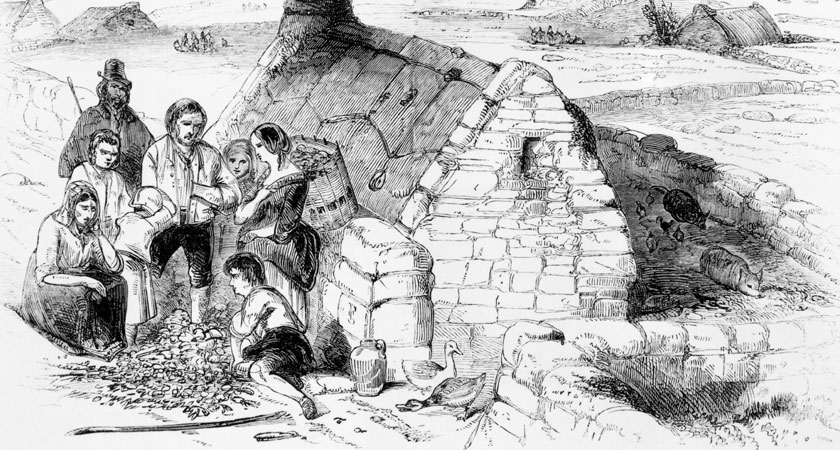SINCE 1995, the 150th anniversary of the first appearance of the potato blight in Ireland, there has been an explosion of interest in the topic of the Great Hunger.
This has been evidenced by an outpouring of books, conferences and summer schools, international memorials and artwork, new heritage centres and museums, poetry and music - most recently an opera, which commemorates Asenath Nicholson.
Since that date also, many publications have been released that have greatly added to our knowledge of this tragic period in Irish history.
Yet, despite this outflow of research and writing, certain areas still remain relatively unexplored.
This is true of the experience of women, not simply as victims of the Hunger, but in the numerous and varied roles that they played – as landlords, as care-givers, as activists, as emigrants, as writers, as critics of government policies, and as petitioners, philanthropists and proselytisers.
Women and the Great Hunger (Quinnipiac University Press and Cork University Press, 2017) utilises new perspectives to examine how women both suffered and shaped events in Ireland after 1845.
The book opens with a chapter on Cecil Woodham-Smith and her classic account of the Famine, The Great Hunger, which was published in 1962 to great international critical acclaim and commercial success.
Academics in Ireland, who were overwhelmingly male, were less welcoming, however.
The chapter explores why this book and its author became the scourge of revisionist historians for many decades, one leading scholar even describing Woodham-Smith as a ‘zealous convert’ to nationalist propaganda.
Chapters by Ciarán Reilly, Gerard MacAtasney and Cara Delay show the agency of individual poor women as agitators for relief in the face of the breakdown of family and community.
An example of this is a petition, written by Widow Kilmartin of Strokestown in Roscommon to her landlord in July 1848, in which she pleads:
Honorable Sir, I humbly request you won’t be displeased with me for this addressing you hoping the extent of your mercy shall be fully shown forth to me in this my pitiful case by giving me time for this rent until harvest – I have buried my husband and two children this month past and lost your rent by burying them
Sadly, many of these and similar petitions appear to have fallen on deaf ears.
In contrast, the chapter by Sandy O’Hare and Bob Young, on Lady Sligo of Westport House in County Mayo, reveals a different side of Anglo-Irish Ascendancy.
Her private letters, held by Quinnipiac University, show her sympathy towards the local poor, a concern which was also evident in her 25-year-old son, the Marquis of Sligo.
Both were critical of the policies being pursued in London, in particular of the interventions by Charles Trevelyan of the Treasury.
Oonagh Walsh’s chapter on The Great Famine and Epigenetic Change in Ireland builds on recent advances in medicine to show the longer-term psychological and physiological impact of the trauma.
One of the legacies was the high rates of mental illness amongst survivors and their children in the decades that followed.
Her research is a timely reminder that the consequences of prolonged hunger and famine carry on long after the crisis is officially declared to be ‘over’.
It raises question, when did the Great Hunger end?
Just as the impact of the Famine continued well after 1852, it also spread far beyond the shores of Ireland.
Chapters by Gerard Moran, Rebecca Abbott and Jason King explore female emigration to Canada and Australia.
King examines the role played by the Grey Nuns of Montreal, Montreal being the next part of the journey for those emigrants to Canada who survived the rigours of the Atlantic crossing and the quarantine station at Grosse Isle.
In 1847 alone, 70,000 poor Irish immigrants, many of them ill with fever, arrived in Montreal, a city of 50,000 people.
A number of female religious orders, with the Grey Nuns in the vanguard, responded by opening fever sheds on the dockside.
Seventeen Sisters died doing this work. The nuns also kept meticulous records, mostly in French, which chart their uncompromising compassion.
One of the records notes the presence of weeping ‘little children who were clasped in the arms of their mothers who had died during the night’ in the fever sheds.
Other contributors include Maureen Murphy, Maureen O’Connor, Amy Martin, and Matthew Skwiat, who explore the role of other redoubtable women including Asenath Nicolson, Frances Cobbe and ‘Speranza’, all eye-witnesses to the tragedy in Ireland.
While Daphne Wolf looks at the neglected issue of clothing, with many famine victims being ‘nearly naked’, and Eileen Moore Quinn explores the role of folk-lore amongst emigrants.
Turlough McConnell, in turn, explores the contribution of the Sisters of Charity in New York, in the tantalisingly named chapter, How the nuns of New York tamed the gangs of New York.
The book concludes with a challenging, and even provocative, personal reflection by Ruth Riddick, an Irish human rights activist.
While showing how far the women’s movement has come in a relatively short time, she argues against complacency, arguing that reversals will be made unless we are vigilant.
It is a timely warning.
Shortly after the publication of The Great Hunger, Cecil Woodham-Smith gave an interview in Dublin in which she praised the ‘stead-fastness of women’ during the Famine.
This book makes a contribution to uncovering some of these stories, while acknowledging that far more work remains to be done.
Professor Christine Kinealy is Director of Ireland’s Great Hunger Institute at Quinnipiac University. Her publications include This Great Calamity, which won an ‘Irish Post award in 1995, and The Bad Times/An Droch Shaol (Quinnipiac University Press and Coiscéim, 1916), which is a graphic novel about the Great Hunger.



